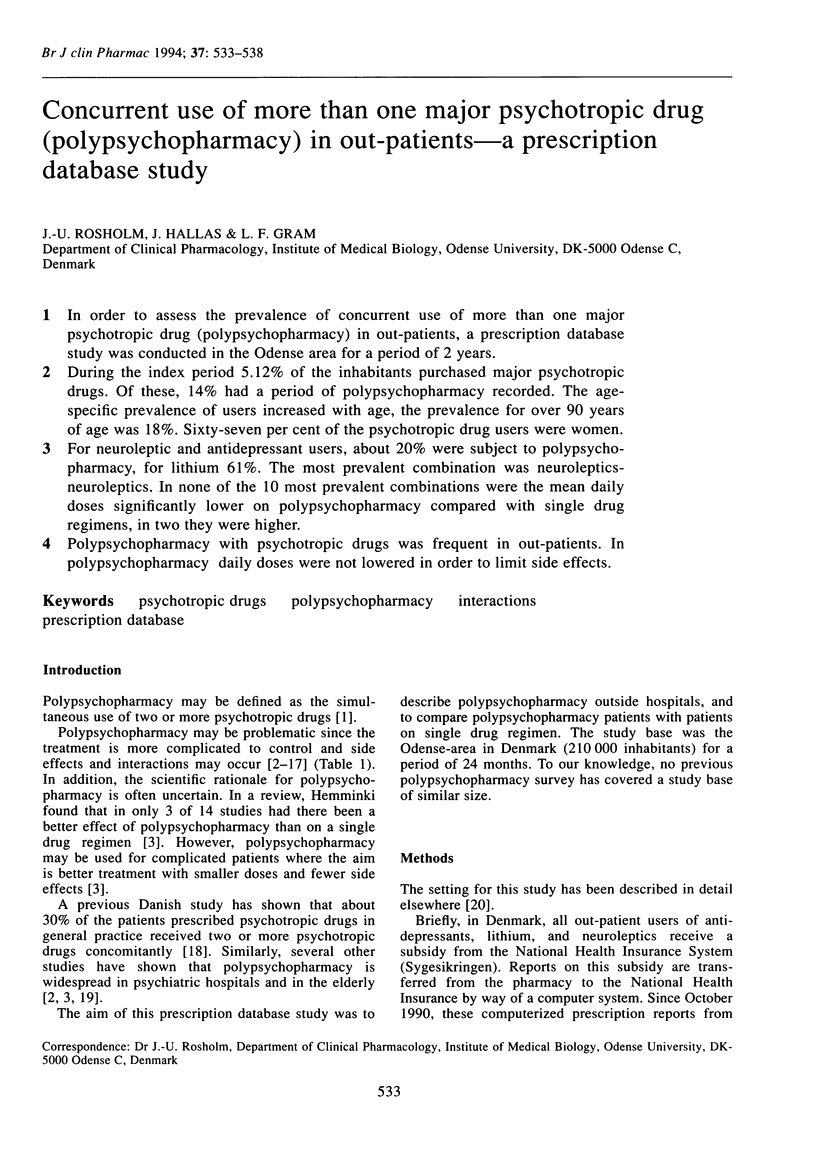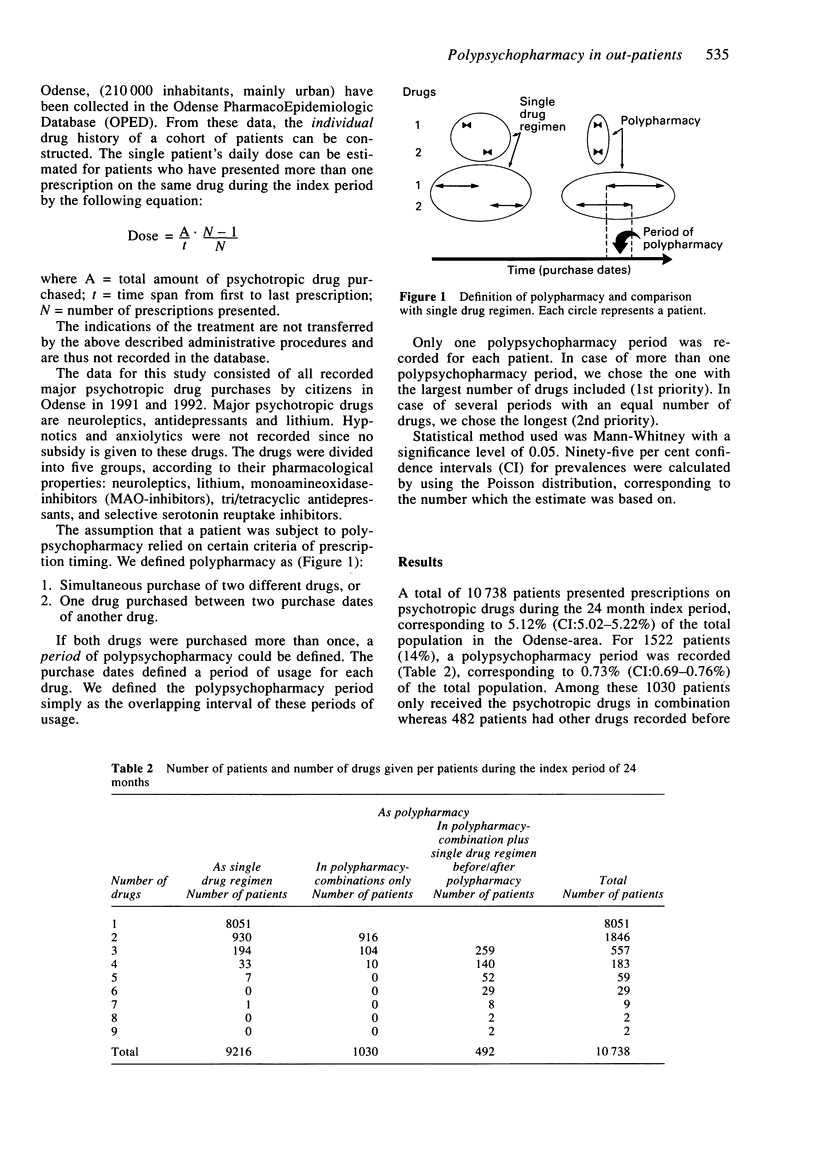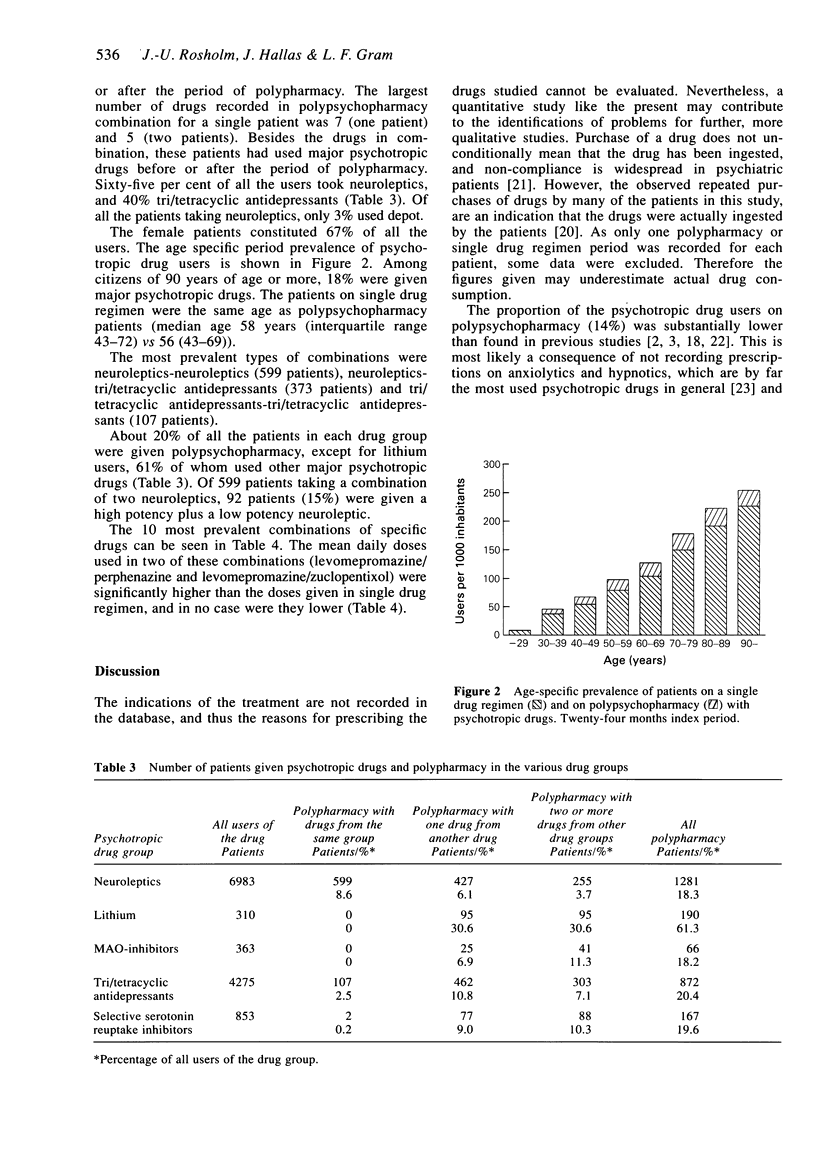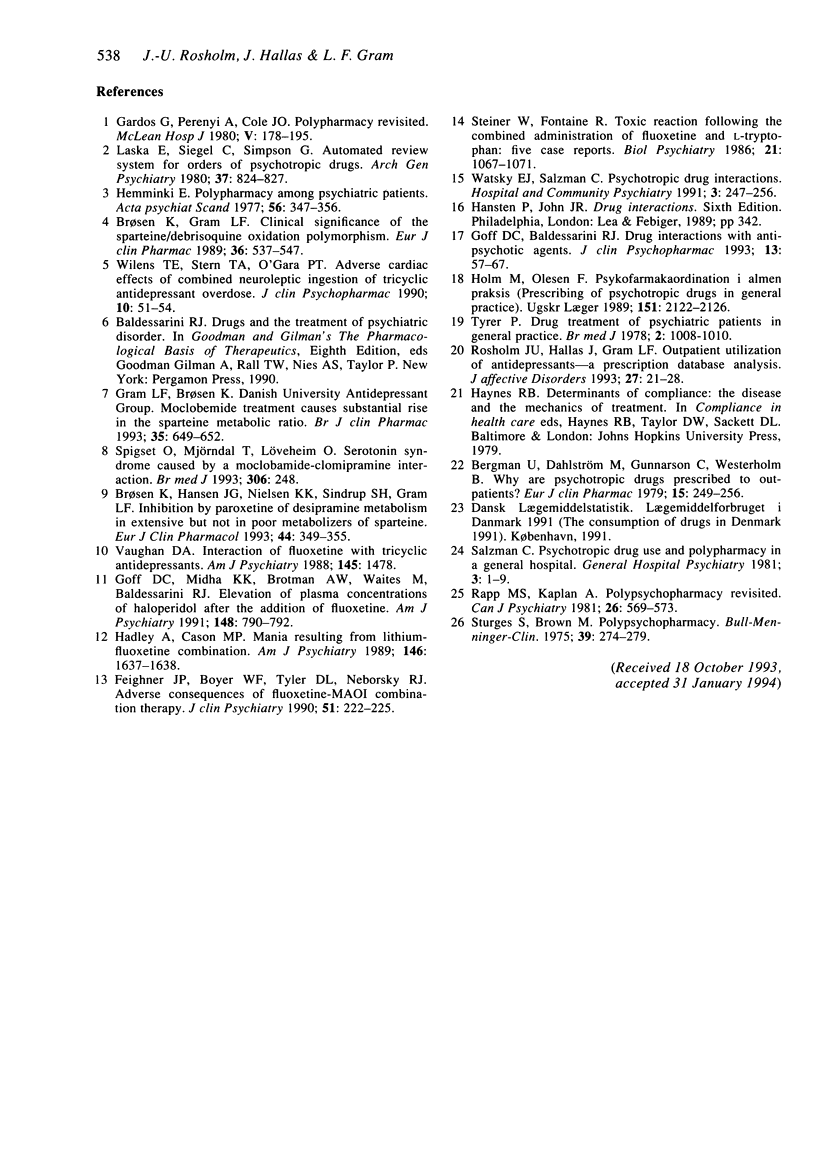Abstract
1. In order to assess the prevalence of concurrent use of more than one major psychotropic drug (polypsychopharmacy) in out-patients, a prescription database study was conducted in the Odense area for a period of 2 years. 2. During the index period 5.12% of the inhabitants purchased major psychotropic drugs. Of these, 14% had a period of polypsychopharmacy recorded. The age-specific prevalence of users increased with age, the prevalence for over 90 years of age was 18%. Sixty-seven per cent of the psychotropic drug users were women. 3. For neuroleptic and antidepressant users, about 20% were subject to polypsychopharmacy, for lithium 61%. The most prevalent combination was neuroleptics-neuroleptics. In none of the 10 most prevalent combinations were the mean daily doses significantly lower on polypsychopharmacy compared with single drug regimens, in two they were higher. 4. Polypsychopharmacy with psychotropic drugs was frequent in out-patients. In polypsychopharmacy daily doses were not lowered in order to limit side effects.
Full text
PDF





Selected References
These references are in PubMed. This may not be the complete list of references from this article.
- Bergman U., Dahlström M., Gunnarsson C., Westerholm B. Why are psychotropic drugs prescribed to out-patients? A methodological study. Eur J Clin Pharmacol. 1979 May 21;15(4):249–256. doi: 10.1007/BF00618513. [DOI] [PubMed] [Google Scholar]
- Brøsen K., Gram L. F. Clinical significance of the sparteine/debrisoquine oxidation polymorphism. Eur J Clin Pharmacol. 1989;36(6):537–547. doi: 10.1007/BF00637732. [DOI] [PubMed] [Google Scholar]
- Brøsen K., Hansen J. G., Nielsen K. K., Sindrup S. H., Gram L. F. Inhibition by paroxetine of desipramine metabolism in extensive but not in poor metabolizers of sparteine. Eur J Clin Pharmacol. 1993;44(4):349–355. doi: 10.1007/BF00316471. [DOI] [PubMed] [Google Scholar]
- Feighner J. P., Boyer W. F., Tyler D. L., Neborsky R. J. Adverse consequences of fluoxetine-MAOI combination therapy. J Clin Psychiatry. 1990 Jun;51(6):222–225. [PubMed] [Google Scholar]
- Goff D. C., Baldessarini R. J. Drug interactions with antipsychotic agents. J Clin Psychopharmacol. 1993 Feb;13(1):57–67. [PubMed] [Google Scholar]
- Goff D. C., Midha K. K., Brotman A. W., Waites M., Baldessarini R. J. Elevation of plasma concentrations of haloperidol after the addition of fluoxetine. Am J Psychiatry. 1991 Jun;148(6):790–792. doi: 10.1176/ajp.148.6.790. [DOI] [PubMed] [Google Scholar]
- Gram L. F., Brøsen K. Moclobemide treatment causes a substantial rise in the sparteine metabolic ratio. Danish University Antidepressant Group. Br J Clin Pharmacol. 1993 Jun;35(6):649–652. doi: 10.1111/j.1365-2125.1993.tb04196.x. [DOI] [PMC free article] [PubMed] [Google Scholar]
- Hadley A., Cason M. P. Mania resulting from lithium-fluoxetine combination. Am J Psychiatry. 1989 Dec;146(12):1637–1638. doi: 10.1176/ajp.146.12.1637a. [DOI] [PubMed] [Google Scholar]
- Hemminki E. Polypharmacy among psychiatric patients. Acta Psychiatr Scand. 1977 Nov;56(5):347–356. doi: 10.1111/j.1600-0447.1977.tb06676.x. [DOI] [PubMed] [Google Scholar]
- Holm M., Olesen F. Psykofarmakaordination i almen praksis. 1. En registreringsundersøgelse i Arhus amt. Ugeskr Laeger. 1989 Aug 21;151(34):2122–2126. [PubMed] [Google Scholar]
- Laska E., Siegel C., Simpson G. Automated review system for orders of psychotropic drugs. Arch Gen Psychiatry. 1980 Jul;37(7):824–827. doi: 10.1001/archpsyc.1980.01780200102013. [DOI] [PubMed] [Google Scholar]
- Rapp M. S., Kaplan A. Polypsychopharmacy revisited. Can J Psychiatry. 1981 Dec;26(8):569–573. doi: 10.1177/070674378102600811. [DOI] [PubMed] [Google Scholar]
- Rosholm J. U., Hallas J., Gram L. F. Outpatient utilization of antidepressants: a prescription database analysis. J Affect Disord. 1993 Jan;27(1):21–28. doi: 10.1016/0165-0327(93)90092-x. [DOI] [PubMed] [Google Scholar]
- Salzman C. Psychotropic drug use and polypharmacy in a general hospital. Gen Hosp Psychiatry. 1981 Mar;3(1):1–9. doi: 10.1016/0163-8343(81)90016-5. [DOI] [PubMed] [Google Scholar]
- Spigset O., Mjörndal T., Lövheim O. Serotonin syndrome caused by a moclobemide-clomipramine interaction. BMJ. 1993 Jan 23;306(6872):248–248. doi: 10.1136/bmj.306.6872.248. [DOI] [PMC free article] [PubMed] [Google Scholar]
- Steiner W., Fontaine R. Toxic reaction following the combined administration of fluoxetine and L-tryptophan: five case reports. Biol Psychiatry. 1986 Sep;21(11):1067–1071. doi: 10.1016/0006-3223(86)90287-8. [DOI] [PubMed] [Google Scholar]
- Sturges S., Brown M. Polypsychopharmacy. Bull Menninger Clin. 1975 May;39(3):274–279. [PubMed] [Google Scholar]
- Tyrer P. Drug treatment of psychiatric patients in general practice. Br Med J. 1978 Oct 7;2(6143):1008–1010. doi: 10.1136/bmj.2.6143.1008. [DOI] [PMC free article] [PubMed] [Google Scholar]
- Vaughan D. A. Interaction of fluoxetine with tricyclic antidepressants. Am J Psychiatry. 1988 Nov;145(11):1478–1478. doi: 10.1176/ajp.145.11.1478b. [DOI] [PubMed] [Google Scholar]
- Watsky E. J., Salzman C. Psychotropic drug interactions. Hosp Community Psychiatry. 1991 Mar;42(3):247–256. doi: 10.1176/ps.42.3.247. [DOI] [PubMed] [Google Scholar]
- Wilens T. E., Stern T. A., O'Gara P. T. Adverse cardiac effects of combined neuroleptic ingestion and tricyclic antidepressant overdose. J Clin Psychopharmacol. 1990 Feb;10(1):51–54. doi: 10.1097/00004714-199002000-00010. [DOI] [PubMed] [Google Scholar]


